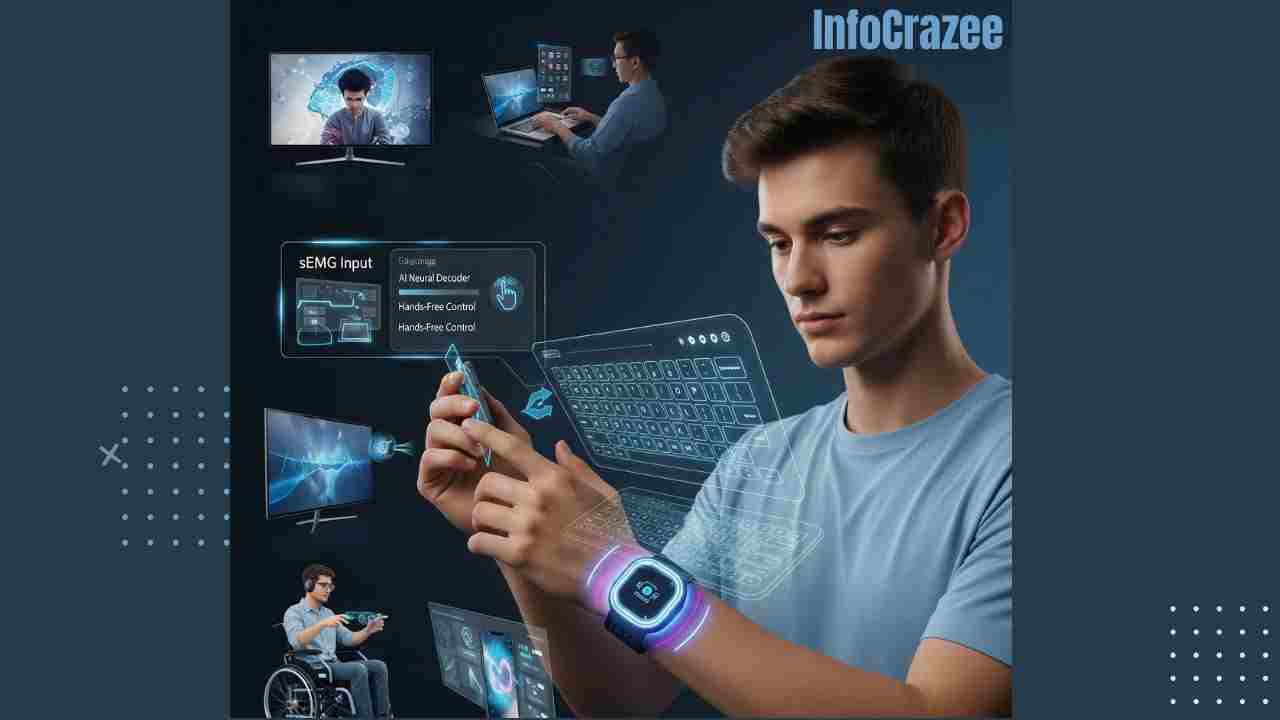Meta’s AI Wristband Revolutionizes Interaction: Type, Scroll, and Control Devices Without a Screen
Meta’s Reality Labs has unveiled a groundbreaking neuromotor wristband that redefines human-computer interaction, allowing users to type, scroll, and control devices without touching a screen or keyboard. Detailed in a peer-reviewed study published in Nature, this AI-powered wearable uses surface electromyography (sEMG) to translate subtle muscle signals into precise digital commands, offering a glimpse into the future of hands-free technology. With applications ranging from gaming to accessibility, the wristband has sparked global excitement for its potential to transform how we engage with devices.
How It Works: Capturing Intent
The wristband employs sEMG to detect electrical signals generated by forearm muscles when a user moves—or even intends to move—their fingers. These signals, produced by alpha motor neurons in the spinal cord, are processed in real-time by advanced machine learning algorithms trained on data from thousands of users. This enables the device to interpret gestures like tapping, pinching, or writing in the air, converting them into actions such as typing text, moving a cursor, or opening apps. Remarkably, with practice, users can activate these commands without physical movement, relying solely on the intention to move, achieving a typing speed of up to 20.9 words per minute.

“It’s not mind-reading—it’s intention-reading,” said Thomas Reardon, Vice President of Research at Meta Reality Labs. “The wristband captures what your brain intends your muscles to do, translating it into digital commands before you even move.” This non-invasive approach distinguishes it from brain-computer interfaces like Neuralink, offering a practical, scalable solution for everyday use.
Accessibility and Universal Design
Meta’s wristband promises significant benefits for accessibility. In collaboration with Carnegie Mellon University, researchers are testing the device with individuals who have spinal cord injuries or limited mobility. Even in cases of partial paralysis, residual muscle signals can be detected, enabling users to control smartphones or computers with unprecedented ease. “This could be life-changing for people with physical limitations,” said Patrick Kaifosh, Director of Research Science at Meta Reality Labs. “Our goal is a device that works out of the box for billions of users.”

The wristbands AI model, trained on data from over 10,000 participants, adapts to diverse movement patterns, ensuring robust performance across users without individual calibration. Meta has open-sourced datasets, including a new one from 300 participants, to encourage global innovation in neuromotor interfaces.
Real-World Applications
Demonstrations showcased the wristbands versatility: users wrote “hello world” in mid-air, with text appearing instantly on a paired smartphone, and navigated apps with subtle finger taps. Integration with Meta’s experimental smart glasses, which support photo capture and audio playback, hints at its role in augmented reality (AR) ecosystems. Future iterations could enable seamless control of AR interfaces, smart home devices, or gaming platforms, reducing reliance on traditional input methods.
The technology’s low-power design and Bluetooth connectivity make it compatible with existing devices, while its compact form factor ensures wearability. Meta plans to refine the wristband for commercial release within the next few years, potentially integrating it into its broader wearable portfolio, including a smartwatch codenamed “Milan” set for a September 2025 debut.
Industry Impact and Future Potential
The wristbands launch has drawn praise for its potential to disrupt the $100 billion wearable technology market. Analysts at IDC describe it as a “leap forward” in human-computer interaction, offering a non-invasive alternative to brain implants while outperforming less reliable EEG-based headsets. Its ability to scale across diverse users sets a new benchmark for neuromotor interfaces, challenging competitors like Apple and Google to accelerate their wearable innovations.
However, challenges remain, including improving gesture recognition in noisy environments and expanding support for complex tasks like video editing. Meta’s ongoing research aims to enhance the wristbands bandwidth and integrate it with AR and virtual reality platforms, positioning it as a cornerstone of the metaverse.
A Vision for the Future
Meta’s wristband represents a bold step toward intuitive, inclusive technology. By harnessing AI to bridge the gap between human intent and digital action, it paves the way for a world where devices respond seamlessly to our thoughts and gestures. As Meta continues to refine this technology, it invites developers and researchers to build on its open-source foundation, fostering a new era of innovation.






